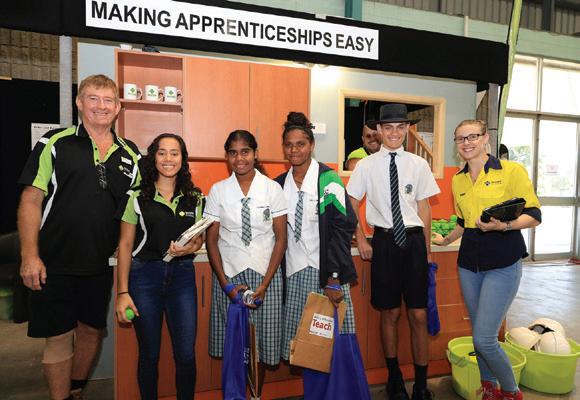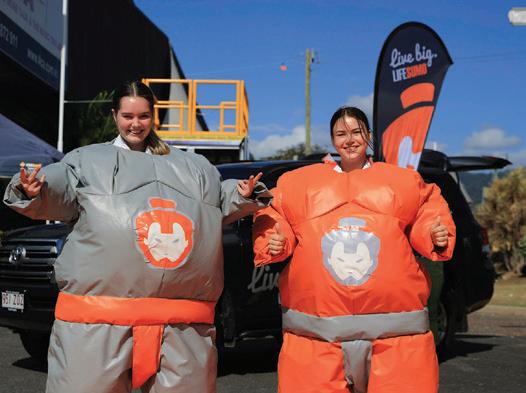
19 minute read
CITYLIFE BUSINESS
THE POWER OF PR™
WHATEVER YOU DO, INVEST IN YOUR CUSTOMERS
Advertisement
DANAE JONES
Danae Jones is Managing Director of PR & Marketing firm Danae Jones Consulting Pty Ltd
: danae@danaejones.com.au : www.danaejones.com.au

Sources: [Prospering in Tough Economic Times through Loyal Customers, 2020] [Goldman and Cowley, 2012] It is very easy to switch to a cost cutting mentality to increase profit margins and stem the cash losses in a business during an economic downturn, but when you start slashing from the line items that actually assist in generating revenue for your business, it is a slippery slope that I strongly advise against. We must think much longer term as business owners in tough economic times with every decision we make. And if you, or those around you see Marketing and Public Relations as an unessential cost to your business, then I stand before you to challenge that thought process.
Those who look at the long game and value customer retention are always the biggest winners as the economy rebounds and not only does history tell us this, evidence proves it. And many local business success stories are living testaments to this. But don’t just take my word for it, let me share with you some other expert insights.
According to a research paper out of the United States, Prospering in Tough Economic Times through Loyal Customers published in the International Journal of Management and Economics, a focus on customer loyalty and retention through strategic public relations techniques is critical to long-term business survival.
The research paper cites that “it takes exceptional management mettle and longterm clearsightedness to avoid this common managerial reaction which can lead to counterproductive and sometimes disastrous results for the company’s future. In severe economic downturns, only a few business leaders have the courage and wisdom to invest in customer loyalty to increase profits instead of reactively cutting costs to try to maintain falling profit margins.”
Based on quantitative and qualitative research, the study findings identify and explain key customer loyalty measures, including: customisation for customers, communication interactivity, nurturing of customers, commitment to customers, customer sharing networks, customer focused product assortments, facile exchanges and customer engagement. There are three key points in the research I would like to share with you:
1. Investing in Customer Loyalty
“Following the dotcom bubble in 2000, most companies focused on the shortrun by hunkering down, reducing their spending, and trying to find as many ways as possible to reduce costs. Under the leadership of CEO Steve Jobs, however, Apple ramped up research and development to develop groundbreaking new products like the iPhone, iPod, iTunes, and iPad, while also spinning out uniquely designed, more reliable computer desktop and laptops, and building offline Apple retail stores. Jobs was an exceptional business leader – one who kept his focus on the longrun by developing great products and superior customer service that delighted customers while more traditional CEOs focused on costcutting and maintaining shortrun profits during tough economic times. Largely due to the visionary genius and contrarian strategies employed by Jobs during an economic downturn, Apple became the most valuable company in the world,
2. Why is Customer Loyalty So Important?
“One of the most fundamental tenets of savvy business management is to attract and retain profitable loyal customers. Compared to average customers, loyal customers buy more, are less costly to serve because they are higher up on the learning curve with your company, more willing to go upscale and pay premium prices, more receptive to buying brand extensions and new products, more forgiving when problems occur, most likely to refer other people to your business, more resistant to competitors’ offers, and the highest contributors to your company’s bottomline profits. Profits can be increased by either reducing costs or by increasing revenues, and loyal customers can do both for your business.”
3. Tracking Customer Loyalty Measures
“Progressive company managers will conduct research to accurately measure, benchmark, and regularly compare their performances on key customer loyalty measures with each of their different customer groups versus past performances, managerial goals, and the relative performances of major competitors. By keeping track of how they are doing in terms of critical customer loyalty measures, companies can obtain insights and early warnings that will allow them to adjust their customer relationship strategies and tactics to retain their profitable loyal customers. Companies that are most successful in achieving high customer loyalty levels in the fierce domestic and global competition ahead should prosper.”
So who are some of the global business success stories who have implemented this methodology and thrived? • Netflix • Lego • Mailchimp • Apple
You might think, well they are much bigger businesses than mine, how could I possibly have the capacity to do what they did?
Well let me give you some local examples to bring it back to FNQ: • Totally Workwear Cairns • Skyrail • CaPTA Group • Norlift • CityLife Magazine • Tea Lily Fashion Boutique
These are just a handful of businesses who’ve all well and truly punched through the 20 and 25 year milestones in business and still lived to fight another day. So go and talk to them, support their businesses and see what it is that they have done to ride the economic waves over the years. I think you’ll find that looking after their customers has always been their main focus.
As we enter unchartered waters in these COVID times, I challenge you when you make every business decision, that you always have the customer at the forefront of your mind and consider, not only, how will this affect me and my business … but how will this affect my customers?
WHAT ARE THE THINGS TO DO BEFORE YOU LEAVE A RELATIONSHIP?
NARDINE COLLIER

Nardine Collier is an accredited Specialist in Family Law, a Family Law Mediator, and Director of Collier Family Lawyers and Cairns Mediations.
: 0428 526 568 : (07) 4214 5666 : nardine@collierlawyers.com.au : www.collierfamilylaw.com.au
I love lists!! Where would we be without them. Here is a checklist of “things to do” at the point where you are considering separation or, just after. This is an edited version of the checklist. You will find the full version on our website.
If you are still able to communicate amicably make a list of joint expenses and work out how much needs to be paid into an account per week, fortnight etc. to pay those expenses as they fall due. It’s Ok to keep a joint account open for that purpose if you trust each other not to misuse it.
Work out how much you can each afford to contribute to that account based on your income and other expenses not covered by the joint list. If you have the larger income and the other parent is going to be having the children most of the time, offer financial support. Don’t wait to be hit with an application for child support or spousal maintenance.
And if things are not that amicable? What steps can you take to protect your assets until you can resolve your property division?
Real property such as houses – Are you on the title? If not you should get legal advice about lodging a caveat.
If you rent, can you change the lease to your sole name? Or have your name taken off?
Bank accounts – Open a bank account in your name only and get your income paid into this account. With joint accounts, talk to the other person about closing off joint bank accounts and dividing the amounts in there. Failing that ask the bank to freeze the account or make it so that both signatures are required.
Credit cards – If the credit card is in your partner’s name can you stop using it? If it is in your name and he/she has a card – consider cancelling it. With joint credit cards – consider cancelling or freezing the account. Change all PINs and passwords.
With mortgages, loans and bills
– Are you on the mortgage? If not you need to take steps to stop the other person increasing the mortgage unreasonably. If you don’t know, find out what debt you are legally liable for? Don’t forget guarantees. Let the lender know you have separated, keep in contact if you are having trouble making repayments. Is there a redraw option? How can you stop the other person using the redraw? Eg – joint signatures for any withdrawals.
Bills – The person staying in the home should put all utility bills (phone, internet, electricity, gas) in their name only – the person moving out, should have their name taken off. You should get a balance as at the date of separation.
Superannuation – If you are worried the other person may be able to access their super get legal advice about applying for a “flag” (stopping the other person being able to draw down their super). Check who your beneficiary is on your super, if it is your ex-partner you might want to change it to your children for example.
Companies and other financial
entities – Do you know how assets are owned – i.e. by a company or Family Trust? Do you know what the consequences to you might be for company debt?
Will – Update your will as being separated does not cancel your existing will. Divorce may invalidate it.
Life insurance – review the level of cover, are the named beneficiaries still correct?
Power of attorney / Advance Plan
– if you have something in place is it still what you want?
An important step in this process is to get as much information about your financial situation as you possibly can, and get some legal advice.
• All Family law matters • Affordable Rates • Flexible Payment Options • Family & Workplace Mediation • Wills
M: 0428 526 568 P: (07) 4214 5666 www.collierfamilylaw.com.au
BREAKING DOWN BARRIERS FOR BUSINESS
PATRICIA O’NEILL

Chief Executive Officer Cairns Chamber of Commerce
The Cairns Chamber of Commerce joins with every business in the excitement of welcoming the first of international visitation in over a year. We look forward to the financial stimulus this will bring to our economy as well as families and friends from across the ditch being able to once again reunite.
During COVID-19 we witnessed the departure of many thousands of skilled and unskilled workers. As many of you would already know the CCoC has been the official certifying body for the Skilled Employer Sponsored visa program (formerly RCB) for Far North Queensland for several years, assisting businesses to access hard to fill positions. The reality is, despite the tough economic times and rising unemployment, skilled and unskilled migrants still exist within Australia on temporary visas and there are many industries desperate to engage with them. The unfortunate situation that our local businesses continuously find themselves in, is that despite consistent attempts at advertising these positions in an attempt to provide employment for Australians first, the appetite is just not there to pick up the work previously carried out by our migrant workers.
CCoC is awaiting final sign off from the Federal Government on our Far North Queensland Designated Area Migration Agreement (FNQ DAMA), which will allow a wider geographical coverage and include critical occupations not currently on the approved list. This will allow for various sectors of business including but not limited to, the professional sector, hospitality and agricultural industry, to have the ability to engage with these migrant workers and deliver greater economic outcomes for our region. We are also actively working with DESBT (Dept Employment, Small Business & Training) to contribute to a regional jobs committee which will highlight key areas where we are experiencing regional skills and workforce shortages.
In March we consolidated an already effective partnership with myself and President Sally Mlikota co-signing the Small Business Friendly Councils Charter (SBFC) with Mayor Bob Manning. The Small Business Friendly Councils (SBFC) initiative recognises a commitment by councils to be mindful of small businesses, their issues and priorities when making decisions for the local community.
In May we will be hosting various events in celebration of Queensland small business month. There is sure to be topics that will relate to all business sectors, so watch this space! To ensure you don’t miss any of these opportunities, visit www. cairnschamber.com.au/events. We will be posting regular event updates.
The Cairns Chamber of Commerce is here to help business. That is our primary focus. We take our responsibility as the peak body for business representation in the Cairns region very seriously. Serving our members is at the very heart of all that we do. Assisting businesses grow by connecting them to opportunities, and to act in the best interests of the Cairns regional business community by advocating on their behalf to all three levels of government. We will continue to fight for business.

BALANCING LEADERSHIP DIVERSITY IN THE TROPICAL NORTH
SONJA JOHNSON

Chief Executive Officer Regional Development Australia Tropical North (RDA)
Since Regional Development Australia’s (RDA) inception over a decade ago, the national network of 52 committees has seen subtle changes to the network’s purpose and charter. These incremental changes are influenced by the Federal Government’s priorities, emerging regional challenges and intelligence from RDA committees.
Each RDA committee is made up of local leaders who work with all levels of government, business and community groups to support the economic development of their regions. The committees have an active and facilitative role in their communities with a clear focus on growing strong and confident regional economies that harness their competitive advantages, seize economic opportunities and attract investment.
Regional Development Australia Tropical North (RDATN) has within its economic development remit, a geographic area covering approximately 16 percent of Queensland’s land mass, 21 local government areas, more than 60 traditional owner groups and one of the highest Aboriginal and Torres Strait Islander populations (14 percent).
RDATN, like the other 51 RDAs, are incorporated not-for-profit entities, governed by a group of local volunteers. Each committee can set its own membership seats, with the Chair appointed by the Minister for Infrastructure, Transport, Regional Development and Communications.
From a Federal Government perspective, each committee should aim to have an equal balance of men and women and some representation of Aboriginal and Torres Strait Islander peoples. It would also be prudent to ensure sub-regional representation, for example, from remote council areas. While commendable, the challenge of meeting diversity requirements alongside representation that provides the skill sets needed to meet the organisation’s objectives, is constantly at the forefront of the Executive’s minds during times of committee member recruitment. The most recent change to the RDA Charter in October 2020, saw a decided shift to facilitating local procurement outcomes, promoting Australian government policies and research and provision of evidence-based advice on regional development issues. There is also a requirement to develop a strategic regional plan – this supports the notion of RDAs acting as ‘umbrella’ organisations for their respective region through coordination of existing plans and priorities authored by various economic development agencies and community organisations. Balancing the governance diversity requirements of the Federal Government with the industry, innovation, entrepreneurship, business, social services and environment/conservation skills needed to achieve the RDA Charter can become insurmountable. It is difficult to find leaders who have both the diversification element and necessary qualifications or work-based experience. Whilst our Charter calls for a 50/50 male-female ratio in selection of the committee, the main focus has been on the ability of members to lead our region forward and portray strong leadership skills within the organisation. We have been fortunate enough to have both, with a mix of business, industry, academic and local government expertise from community members who currently lead or have led, organisations and companies.
Moving forward, RDATN is focused on leadership diversity as a principle, not a policy. Our principle is to find local leaders who meet the skill requirements necessary to advance our agenda and fulfil our strategic objectives. Prospective candidates are scored based on their qualifications and experience – in the instance where multiple candidates are all exemplary based on merit, the vacancy will be awarded to the individual who also meets diversity criteria. Through this principle-based method, RDATN aims to meet the organisation’s Charter and deliver key economic outcomes for the Far North Queensland and Torres Strait region.







TOURISM REBOUND IN SIGHT
MARK OLSEN

Chief Executive Officer Tourism Tropical North Queensland (TTNQ)
Without international travellers, our region loses $3 million a day in international visitor spending. That spending supported thousands of jobs, and underpins some of the region’s core infrastructure including our airport.
For TTNQ, while we are working harder than ever in the domestic market, regaining our international connectivity remains a top priority for us and our partners at Advance Cairns and the Cairns Chamber of Commerce.
It has been encouraging to see domestic aviation capacity returning, both through direct support from the Queensland Government and the recently announced half price airfares supported by the Federal Government.
In May and June we could see our seat capacity exceed the 85,000 seats we had at Christmas time into and out of Cairns, putting us at close to 90 percent of our pre-Covid domestic capacity. But we need to keep driving demand and filling those flights. Airline seats are about more than just visitors, they support the amazing quality of life here in the region. They help bring our friends and relatives to town, and give us options to travel where and when we need to. Our region is one of the most connected regional economies in Australia which also support our thriving agricultural sector. Regaining our direct international services, starting with New Zealand, Singapore, Korea and Japan can help boost tourism numbers, support our community’s connections globally and open up markets for our high value freight to boost our region’s recovery.
The Easter holidays have been good, with strong arrivals over the long weekend and solid bookings over the two weeks of the school holidays. Operators are now reporting strong bookings out to September. TTNQ is continuing our push to get first time visitors to the region, with a strong advertising push for the region in the southern capitals as the weather starts to cool.
All the hallmarks are there for our future success, Cairns is the third most Googled holiday destination in Australia (after Sydney and Melbourne), during the recent airline seat sales Sydney to Cairns was the fourth most popular route and the Cairns Holiday Dollars are delivering hundreds of extra bookings for our tours and attractions.
The announcement of a New Zealand travel bubble from April 18 could see up to 1000 New Zealand travellers a week travelling, if there are direct flights, injecting up to $1M a week into the region.
We remain optimistic that we can ride out the bumps ahead, reopen to international travel across multiple destinations soon, and build a solid base of Australian travellers who love our region and will return.

CONFIDENCE DESTROYED IN SHUTDOWN MADNESS
KEVIN BYRNE

Executive Officer Enterprise North
There is one thing our regional communities crave at all times ― a degree of certainty and not brazen promises that are broken on a whim. For the past year we have seen a constant struggle between those pragmatists who continue advocating for a containment regime of Covid management versus the politically expedient regime of Covid elimination and “keeping everyone safe”. Some have long argued that the first responsibility of governments is to effectively manage ALL aspects of community continuity/ survival including aspects of social resilience, the economy, employment and of course ensuring our health systems are adequately resourced among other things. Unfortunately there have been too few voices.
Right on queue we saw only weeks ago the ridiculous spectacle of Paul Murray Live on Sky imploring Aussies to travel north in front of a masked and socially distanced Cairns audience, when there has been no evidence of community transmission here in 12 months and because a couple of cases were active in Brisbane. In addition, and most disgracefully and callously, we are still being deprived visiting rights in our hospitals, aged care homes and other social restrictions for another two weeks. One particular instance I know is of a mother who has been in Townsville comforting a desperately ill son who is to undergo a bone marrow transplant being told she cannot see him so go home. She is back in Cairns and will return when these senseless restrictions are lifted. Our streets, restaurants, shops, public places and offices are filled with anonymous masks when there is just no case for this when we are 2000km socially distanced from Brisbane HQ. That is the social side and what about the economic side, with the immediate hit to the struggling tourism, accommodation and hospitality sectors. Truth matters here, and undertakings twice in two months that we had seen the end of lockdowns, were broken overnight because of health overreach. The net result of this is our confidence in our contact tracing systems, as well as our current ability to manage hotel quarantine is shattered, resulting in a lack of confidence that Queensland can pursue a containment strategy which is essential for our long-term economic revival and survival. Business and industry advocacy groups have a duty to advocate robustly for a reset here and demand governments pursue the containment strategy within agreed rules to allow some certainty in planning regional recovery.
Our individual and community strength lies in our resilience and an innate ability to recover, repivot and get on with it. Governments need to recognise and respect this and play their part by not meddling unnecessarily, keeping their word, investing in infrastructure that focuses on growing community needs and creating the environment that encourages business investment to create growth alongside job opportunities.











